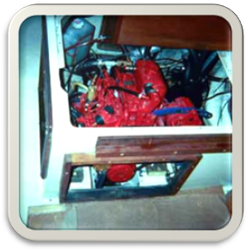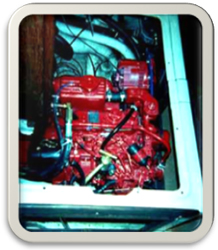
|
This particular Catalina was a 1986 model, that had the Universal M25 diesel engine, rated 21 horsepower, factory installed. I became involved when the owner complained that he could not run the engine for more than one-half hour without it overheating. The symptom was the fresh water coolant recovery bottle would violently spew forth it's
contents. The owner would then refill the bottle, wait for the engine to cool a bit, and restart the engine. Unfortunatly, the symptom was repeated. This was very frustrating for the owner, and severely limited his family's use and enjoyment of the boat.
It was theorized, after some diagnostic tests, that a defective head gasket was the most likely cause for the problem. This was proven to be the case, as evidenced by the gasket condition after the engine head was removed. However, the primary reason for gasket failure was that the cylinder liners were no longer flush with the block face but were significantly recessed, leaving the head gasket unsupported. Here's what happened while the engine was running - the cylinder compression would be directed past the head gasket, due to the above condition, and would overpressurize the fresh water cooling system. It was this pressure that caused the above symptom.
It was further discovered, upon examining the partially disassembled engine, that one piston had, sometime in the past, been installed facing the wrong direction. This indicated the engine lower end was now suspect and should
be completely disassembled for rebuilding.
The owner decided that instead of spending much time and money to rebuild this old engine, the money would be more wisely spent on installing a new Beta Marine engine. Considering that the cost was comparable, and that the new engine would have the latest diesel technology, a new transmission and 2 year warranty, it made sense to repower.
The engine chosen was the Beta Marine BD722, rated 20 horsepower. (See the sidebar below for the repowering options available for the Catalina 30.) This engine is essentially the most recent version of the original engine, as both are Kubota [Japanese] industrial 3 cylinder diesels. Kubota is the world's largest builder of industrial diesels under 100 hp. The BD722 is fresh water cooled, non-turbo charged, with no cylinder liners. The correct transmission ratio for this application was 2:1. The original 2 blade prop was reused, since it was close to the recommended prop specifications.
The owner selected the "C" engine panel that included complete instrumentation, and also included engine warning lights and horn, with an electric push button to stop the engine. No more baulky, rusty stop cables to contend with! The panel fit quite well into the Catalina's original panel area, with minimal modifications. It's an excellent location for the panel, and affords outstanding instrument visibilty and convenience. An extended length wiring harness was ordered from the North Carolina distributor, since the panel and engine were so far apart. The factory blower was wired to operate whenever the engine was running to ensure cool, clean air to the engine.
Engine space is at a premium in the Catalina 30, which dictated that the engine be ordered with the shallow oil pan. It's a no cost option on this engine, as is Atomic 4 engine mounts. This particular engine required standard engine mounts, also a no cost option, because the engine bed stringers are 14.5" apart, on center. The Atomic 4 mounts are 11.5" apart.
The owner also chose the optional 65 amp alternator, instead of the standard 40 amp. This required that a new alternator bracket and different V belt be installed. It all fit fine, after some minor modifications.
The original engine was removed by crane, the engine bed was cleaned and epoxy repaired were it was slightly detached from the hull. This is a common problem with the C30. The owner decided to also remove the prop and shaft for inspection, install a new cutlass bearing, rebuild the stuffing box, and replace the stern tube hose and clamps. Of course, this work is much more easily done with the engine removed. It was also decided to replace all old fuel hoses, exhaust hose, clamps, upgrade the engine intake sea-cock to a 3/4" bronze ball valve, [the original was a 1/2" plastic type] and install a bronze raw water strainer.
The bed was now modified to accept the new engine by installing 2x4 pressure treated lumber [well seasoned] on top of the bed, using stainless lag screws. This located the new engine correctly in the vertical dimention, and considerably strengthened the bed.
The new engine and transmission was now put in place, and secured using stainless lag screws.
A new exhaust system [between the engine and muffler] was fabricated from threaded cast iron pipe, and insulated. A new siphon break was installed, to help prevent raw cooling water from backflowing into the engine. Of course,
all new coolant hoses and marine grade clamps were installed.
The fuel tank was drained, and internally inspected for crud and corrosion. The fuel gauge was installed under the companionway stairs, and is operated by a fused switch, located below, on the original DC panel. This location
protects the gauge from the weather.
The Original Dahl primary fuel filter was removed for cleaning and inspection, and reinstalled with new "O" rings, new element, and a ball valve type drain, to make maintenance quick and easy.
A new coolant recovery bottle was installed in the engine space, with an access panel directly above it. Domestic water heater fittings were installed, so fresh water is heated for showers, cooking, etc., whenever the engine is running.
The original shifter was reused, along with the cables.
Battery cable terminals were replaced with new, heavy duty type, and installed to ABYC standards.
The boat was launched, and allowed to sit overnight before the final engine/shaft alignment. Beta Marine engines have a flexible coupler as standard equipment, that allows for .010" engine/shaft misalignment, and also reduces vibration. Working in concert with the engine mounts, wear and tear on all drive train components, and engine vibration, is greatly reduced.
The sea trial was also a delivery of 10 miles, under power, to the yacht club slip in Guilford, CT. The engine ran very well, with no problems, and powered the boat easily to hull speed. Fuel consumption is about 1.5 liters per hour, at cruise rpm. The owner remarked that the new Beta Marine engine was quieter than the old engine and had a much less stinky exhaust. This can be attributed to the giant strides in diesel technology that have occured in the last 15 years, along with low sulphur fuel. The new engines burn fuel very cleanly, are quick starting, free revving, and operate with little fuel, minimal vibration and noise. They are also more compact and lighter than their predecessors.
The owner now has a very reliable engine, with warranty and local dealer support. He can also obtain engine parts at any Kubota tractor dealer, at reasonable prices, and shop locally for the best deals on oil and fuel filters, Jabsco impellers, and engine zincs. The boat's resale value and saleability have greatly increased. His family's boating experience has greatly improved, and he's very happy, overall, with his decision to repower.
Click on the photos below to get a larger image.


Catalina 30 repower options
If your boat had acceptable performance with the original Universal 5411 diesel engine, [when the engine was new, and developing it's rated 11 horsepower] installation of the Beta Marine BZ482 13.5 hp engine will result in the boat exceeding it's original performance. Also, since this engine is fresh water cooled, and operates at 180 degress F, plenty of hot water for showers, cooking, and dish washing will be available, if a separate hot water tank is installed in the boat.
If one desires more power, to fight strong currents, waves, or wind, the BD722, 20 hp engine will duplicate the performance of the Universal M25, 21hp engine, as installed in the later model boats.
The price difference between these two Beta Marine engines is about $700.
Either engine will fit in the limited engine space of the Catalina 30. The larger 65 amp alternator, optional on the BD722, can be accomidated with minor modifications to the cabin seat.
If your boat had the Atomic 4 gasoline engine installed from the factory, either of the above Beta Marine diesel engines can be ordered with engine mount brackets that duplicate the A-4 engine bed spacing, at no additional
cost. This means only minor modifications are needed to fit the new Beta Marine diesel engine into your boat, saving MUCH time, hassle, and expense.
For comparison, the A-4 is usually operated at 2000 rpm. At this engine speed, the engine is producing 15hp, according to Universal factory literature. The BZ482, 13.5 hp engine will duplicate the performance of the A-4 powered boats. It's also 120 pounds lighter, and consumes about 1 LITER of fuel per hour at cruise rpm. That's very low fuel consumption, which is characteristic of diesel engines. The larger BD722 engine is 234 pounds, which is 76 pounds lighter than the A-4, and is similarily stingy with fuel.
Top of Page
|
|
|



